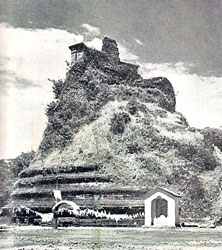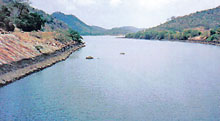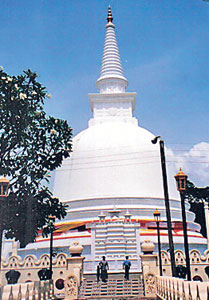Years of neglect following the decline of the ancient Sinhalese kingdom led to most of our historical treasures being ruined. The monumental work by the kings including the multi-storied royal palaces, huge Buddhist stupas and massive tanks and reservoirs were totally abandoned. The spread of diseases like malaria, made the situation worse when people left the 'Raja Rata' which was once labeled the granary of the east, and moved to other parts of the country. Mahiyangana on the banks of the Mahaveli river was one such place which was totally neglected.
Mahiyangana is a holy place for the Buddhists. The stanza to worship the sixteen places hallowed by the visits of the Buddha starts with 'Mahiyangnam Nagadipam, Kalyanam Padalaanchanam...'
referring to Mahiyangana, Nagadipa, Kelaniya and
Sri Pada following the order of the visits.
 |
| Mahiyangana stupa prior to restoration |
Mahiyangana is mentioned first, since the Buddha is said to have
visited Mahiyangana nine months after his enlightenment on the full moon of 'Phussa' (Dec – Jan). Foreseeing that the Dhamma would be established in Sri Lanka he came to dispel the members of the 'yakkha' clan. Having preached to them, the Buddha had promoted the 'yakkhas' to move over to another island called Giri.
In the gathering of the devas listening to the Buddha was Saman deviyo – God Saman, who was very impressed with the preaching. He requested the Buddha to leave behind something to be used as an item of worship. The Buddha gave him a lock of hair which he enshrined in a dagoba at the present site of the Mahiyangana stupa. Thus Mahiyangana became the first ever stupa to be built in Sri Lanka. And it happened during the lifetime of the Buddha.
The stupa was enlarged by Arahat Sarabhu to a height of 12 cubits after receiving and enshrining the collar bone relic of the Buddha taken from the funeral pyre. For the greater protection of the shrine, King Devanampiyatissa's
brother, Prince Uddhaya Culabhaya covered it over and made it 30 cubits high. King Dutugemunu (161–137 BC) who was living in Mahiyangana while fighting the invading forces of the Cholas from South India, enlarged the stupa to 80 cubits high. It was subsequently rebuilt by Vijayabahu I.
An inscription dating from the 10th century gives an example of the unexpected benefits of pilgrimage. When King Udaya IV visited Mahiyangana on pilgrimage some of his subjects begged an audience with him and informed him of numerous malpractices in the local market. The king consequently ordered his officers to draw up new regulations for the better running of the market.
 |
| Sorabora wewa |
Several of the kings of Kandy made pilgrimages to Mahiyangana. King Narendrasinghe went twice and King Veerawickrama performed the whole pilgrimage on foot.
By the 19th century, Mahiyangana was a
forgotten place and even access was most difficult. The whole area was virtually abandoned until recent times. Even after the roads were built, one of the most difficult routes was the road from Kandy to Mahiyangana passing Teldeniya and Hunnasgiriya. One had to negotiate 16 hairpin bends which was no easy task for drivers. Now the road has been widened and the bends are no longer a
problem.
Restoration of the Mahiyangana stupa was talked about after Independence when a society was formed in 1949 to liaise with the Department of Archaeology and undertake the work. Restoration was started by Prime Minister Dudley Senanayake in September 1953.
Mahiyangana today
Today Mahiyangana presents a totally different picture from what it was a few decades ago. It is a prosperous town in the Uva province and occupies a strategic position in the region. One can turn right and go to Bibile and turn left and proceed to Girandurukotte. Mahiyangana is 42 km from Kandy.
 |
| Mahiyangana stupa today. |
Sorabora wewa at Mahiyangana is a tank built by King Dutugemunu. Legend says that Bulatha, the person who cooked food for Dutugemunu's armed forces carried the rocks one by one on his shoulder and built the tank.
The sluice of the tank is considered a marvel because it has been built utilising the massive rock around it. The date of construction is mentioned as
162 BC on the display board set up by the Irrigation Department.
Today it irrigates about two thousand acres of paddy. The main dam is 1590 feet long.
Close to Mahiyangana is the Vedda country. Going along the road to Padiyatalawa, one can turn at the 90th km-post and reach Dambana village, the main location of indigenous people. It is close to Maduru Oya national park.
The annual Mahiyangana procession attracts large crowds. A highlight of the perahera is the participation of the Vedda community. |



